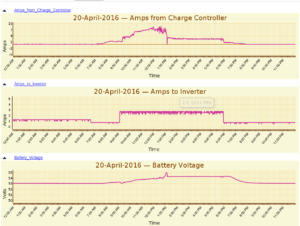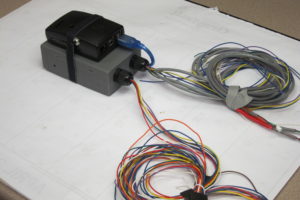The PiJack is an inexpensive data collection device which can collect 16 different DC voltage inputs for plotting on the public powermon.org website. It’s purpose is to monitor the health of battery banks for solar power systems or ac powered backup inverter systems. Below is a static screenshot of some data plots..

For a live example of what the interactive data graphs look like, click here. Click the little black triangles to see each data graph.
The PiJack design is open and one can be built by anyone from commercially available components for about $260 plus shipping.
 The PiJack consists of a Raspberry Pi 3 model B connected by USB to a Labjack U3 data acquisition device. Using a custom case with an OEM version of the Labjack U3 board allows us to add resistor divider network to the analog inputs, allowing for safe use on battery banks rated 48v.
The PiJack consists of a Raspberry Pi 3 model B connected by USB to a Labjack U3 data acquisition device. Using a custom case with an OEM version of the Labjack U3 board allows us to add resistor divider network to the analog inputs, allowing for safe use on battery banks rated 48v.
The “powermon” software running on the raspberry Pi collects the data readings and pushes the files up to our website for plotting. It also can collect data from Outback Power systems devices by listening to the serial port of the Outback “Mate 1” or “Mate 2” device.
Unique features of the PiJack/powermon system are:
- Not limited to a particular brand of hardware, it can monitor anything
- Very Low bandwidth requirements & data use ~40kB per day
- Works well without a full-time internet connection
- Works behind NAT firewalls even if your firewall has a private IP number
- Data readings are collected once per minute in a plain text file
- Each day’s data is collected in a separate text file
- Data isn’t pushed to the web for plotting until the day after (it’s not real-time data)
- Compressed Data files are stored indefinitely on the Raspberry Pi and pushed up to a web server when an Internet connection is available
- Optional inclusion of pagekite software allows remote secure terminal access to the Raspberry Pi for troubleshooting purposes even behind multiple NAT routers
- Can be used without an Internet connection as a data logger with manual retrieval of the data by USB flash drive
The standard design has 3 inputs for current measurement (±150A) using hall effect sensors, and 13 inputs for voltage measuring from 0-60v. However, the system is very flexible. It is possible to configure the inputs on your labjack hardware differently.
Wycliffe or SIL members and affiliates can purchase your pre-built PiJack here.
To upload and plot the data on powermon.org, you will need an account on that site. Normally we will set this up for you when you buy a PiJack device from us. You will need to create an ini file on powermon.org which tells powermon the name of each data input and scaling factors if needed. Usually one of the admins at power_systems@sil.org will help you with this.
Should you want to build your own PiJack device you need to:
-
- acquire the parts — a list of materials is HERE
- Install and configure raspbian on the pi
- You can start with a standard raspbian image and follow THESE steps
- Or start with our pre-configured Jessie image and follow THESE customization steps.
- Solder the parts onto the Labjack U3 OEM board using THESE instructions.
- Print the case on a 3D printer and assemble the parts.

 GTIS Power and Communications Systems
GTIS Power and Communications Systems